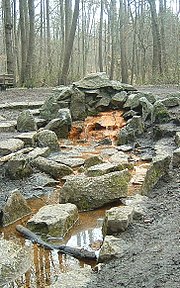Iron hydroxides

As hydroxides (chemically precisely oxide hydrates, iron (III) or as a precipitate in water colloquially ocher called) is substantially a group of substances summarized extending from iron (III) oxide with different hydration can be derived. In addition, iron (II) hydroxide belongs to the group of iron hydroxides , but it is very unstable and is quickly oxidized to iron (III) oxide hydroxide in the presence of atmospheric oxygen . Iron hydroxides are to be distinguished from floating iron , which can form on the surface of temporary still waters.
In nature, iron (III) hydroxides are found as meadow ore Fe 2 O 3 · 3H 2 O, brown iron ore ( limonite ) 2Fe 2 O 3 · 3H 2 O, yellow iron ore Fe 2 O 3 · 2H 2 O, needle iron ore ( goethite ) Fe 2 O 3 · H 2 O, as a sales source for iron-containing sources, also in many minerals and generally as a yellow or brown coloring component in rocks and in the soil.
Iron (III) hydroxide
The iron (III) hydroxide is obtained by precipitating a solution of iron chloride with alkalis , preferably with excess ammonia .
The freshly precipitated iron (III) hydroxide is Fe 2 O 3 · 3H 2 O, extremely voluminous and very difficult to wash out in large quantities. It crystallizes when it freezes, as it does when it is kept under water for a long time, and easily transforms into less watery compounds. The precipitated with ammonia, iron (III) hydroxide was as Ferrum oxydatum fuscum officinal . Also, the at Arsenikvergiftungen applied antidote arsenici contains as an effective ingredient of iron (III) hydroxide. Another iron (III) hydroxide ( precipitated with sodium carbonate ), which used to be offical, is iron saffron ( Crocus Martis aperitivus ).
Iron (III) hydroxide is dark brown, not soluble in water, easily soluble in acids and breaks down in water and iron (III) oxide when heated . It easily transfers its oxygen to oxidizable bodies and turns into iron (II) oxide , which eagerly takes up oxygen again from the air. Therefore, it acts as a putrefactive agent and destroys putrefactive substances contained in liquids. Wood can also be attacked, for example on rusting nails. Iron hydroxide vigorously absorbs gases and therefore has a beneficial effect on arable land; it combines with the roving fibers and some dyes and is used as a stain in dyeing.
Iron (III) hydroxide forms the respective iron salts with acids, but behaves like an acid against strong bases and, when melted with potassium carbonate , expels carbon dioxide itself .
Iron (III) hydroxide oxide is used in granulated form as an adsorbent in water treatment. The most important application worldwide is the removal of arsenic from drinking water with the help of adsorption filters.
Iron (II) hydroxide
Iron (II) hydroxide is obtained by precipitation from ammonium iron (II ) sulfate solution with sodium hydroxide solution. The precipitate quickly turns dark with the formation of red-brown iron (III) hydroxide.
Ferric oxide hydroxide
Iron (III) oxide hydroxide is formed when iron starts to rust in moist air containing carbon or sulfur dioxide . The presence of small amounts of carbonic acid in particular causes iron to be oxidized, whereas clean water or dry air alone does not cause any reaction.
See also
Individual evidence
- ↑ Ernst Schmidt, Johannes Gadamer: Instructions for Qualitative Analysis . Springer-Verlag, 2013, ISBN 978-3-662-29375-1 , pp. 27 ( limited preview in Google Book search).
- ^ Neil D. Jespersen: AP Chemistry . Barron's Educational Series, 2010, ISBN 978-0-7641-4050-1 , pp. 245 ( limited preview in Google Book Search).
- ↑ W. Ternes: Biochemistry of the elements Inorganic chemistry of biological processes . Springer-Verlag, 2012, ISBN 978-3-8274-3020-5 , pp. 111 ( limited preview in Google Book search).
- ^ F. Vieweg: Graham-Otto's detailed textbook of chemistry. - Brunswick . F. Vieweg, 1863, p. 1055 ( limited preview in Google Book search).
- ↑ H. Thoms: II. Chemical part . Springer-Verlag, 2013, ISBN 978-3-642-92324-1 , p. 225 ( limited preview in Google Book Search).
- ↑ subgroup elements, lanthanides, actinides, transactinides Volume 2: transition elements, lanthanides, actinides, transactinide attachments . Walter de Gruyter GmbH & Co KG, 2016, ISBN 978-3-11-049590-4 , p. 1956 ( limited preview in Google Book Search).
- ↑ Testing and optimization of a practicable treatment technology for arsenic removal in drinking water treatment. In: Cleaner Production Germany (CPG) - The portal for environmental technology transfer! Federal Environment Agency, accessed on August 7, 2019 .
- ^ Arnold F. Holleman, Nils Wiberg: Textbook of Inorganic Chemistry , 102nd Edition, de Gruyter, Berlin 2007, p. 1654.


